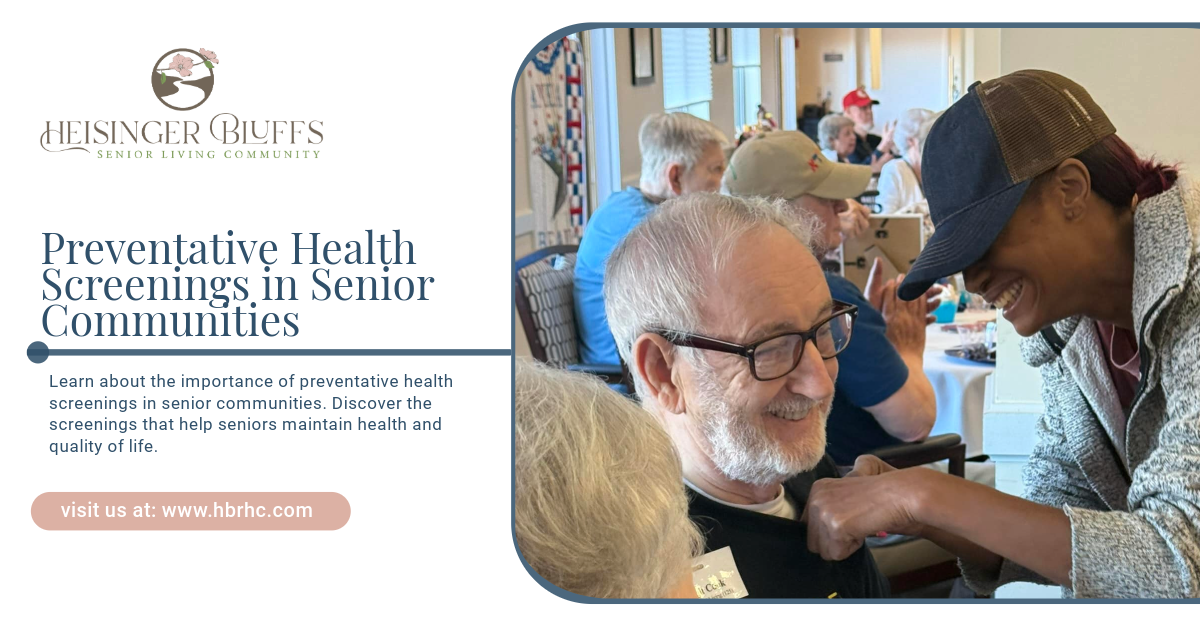Senior Living Daily Activities That Bring Joy and Engagement

Senior Living Daily Activities
As we age, staying mentally, physically, and emotionally engaged is crucial for maintaining a high quality of life. Senior living communities are designed to support residents’ well-being by providing a variety of daily activities that encourage interaction, physical exercise, creativity, and social connection. These activities play a pivotal role in enhancing seniors' emotional health, cognitive abilities, and overall happiness.
In this post, we’ll explore different types of daily activities that can bring joy and engagement to senior living residents. Whether you're looking for ideas to incorporate into your own routine or researching options for a loved one, these activities help create a fulfilling and enriching life in senior living communities.
1. Physical Exercise: Boosting Health and Mood
Physical activity is a cornerstone of senior living well-being.
Regular exercise helps seniors maintain mobility, strengthen muscles, improve circulation, and boost overall health. It also enhances mental health by releasing endorphins, which are the body’s natural mood boosters. Exercise doesn't always mean intense workouts—there are plenty of low-impact activities that can be just as beneficial.
Here are a few types of physical activities that can bring joy to senior living residents:
Chair Yoga
For seniors with limited mobility, chair yoga is a great way to stretch and strengthen muscles without needing to get on the floor. These
gentle stretches can help improve flexibility, reduce stress, and increase range of motion.
Walking Groups
Many senior living communities offer daily walking groups, which are a fantastic way to get some fresh air, socialize, and enjoy the outdoors. Walking also supports cardiovascular health, helps with digestion, and reduces anxiety.
Water Aerobics
Water-based exercises are easy on the joints and are often recommended for seniors. Many communities have pools where residents can participate in water aerobics classes. These exercises provide a low-impact way to stay fit, improve flexibility, and build endurance.
Dance Classes
Whether it’s ballroom, line dancing, or just free movement, dance is a fun and social way to get moving. Many seniors enjoy expressing themselves through dance, and it’s an activity that fosters creativity and joy.
2. Social Activities: Building Connection and Community
Social interaction is essential for mental health, especially in senior living.
Being around others, forming friendships, and engaging in group activities can significantly improve the emotional well-being of seniors. Loneliness and isolation can have negative effects on physical and mental health, so it’s vital to encourage social engagement.
Game Nights
Classic board games like Scrabble, bingo, and dominoes are always popular in senior living communities. Game nights encourage friendly competition, teamwork, and intellectual stimulation. These activities also promote memory and concentration.
Arts and Crafts
Arts and crafts provide an excellent outlet for creativity and self-expression. Whether it’s painting, knitting, or making holiday cards, these activities bring a sense of accomplishment and joy. Crafting can also be a group activity, allowing residents to bond over shared projects.
Book Clubs
For avid readers, book clubs are a great way to stimulate conversation and promote cognitive engagement. Residents can meet weekly or monthly to discuss books, share recommendations, and enjoy lively discussions with others who share their interests.
Themed Social Events
Hosting themed parties or holiday celebrations, such as a 1950s diner night or a Mardi Gras party, allows seniors to experience new cultures, learn about different time periods, and simply have fun. These social gatherings foster a sense of belonging and connection.
3. Cognitive Activities: Stimulating the Mind
Mental stimulation is essential for maintaining cognitive function.
As we age, it’s natural for cognitive abilities to decline, but regular mental challenges can help slow this process. Senior living communities often offer activities that encourage cognitive engagement and mental exercise.
Puzzle Games and Brain Teasers
Puzzles—whether jigsaw puzzles, Sudoku, or word searches—are excellent ways to exercise the brain. They require concentration, problem-solving, and patience, which help keep the mind sharp. These games are also low-pressure activities that can be done solo or as part of a group.
Memory Lane Discussions
Memory lane activities encourage seniors to reflect on their past and share memories with others. These discussions can be guided by prompts like "What was your favorite childhood game?" or "What did you enjoy most about your career?" Not only does this stimulate cognitive function, but it also fosters a sense of nostalgia and emotional connection.
Trivia Challenges
Trivia games are a fun way to engage the mind and learn new facts. Senior living communities can organize trivia nights, where residents work in teams to answer questions on various topics, from history to pop culture. Trivia encourages memory recall and teamwork.
4. Sensory Activities: Enhancing Well-Being
Sensory activities engage the five senses and offer therapeutic benefits.
Seniors often experience a decline in their senses as they age, which can lead to frustration or diminished quality of life. Sensory activities help seniors reconnect with their environment and provide mental and emotional stimulation. These activities are also a great way for those with dementia or memory challenges to stay engaged.
Aromatherapy
Aromatherapy is known for its calming effects and can be a great way to reduce stress and anxiety in seniors. Some senior living communities offer aromatherapy sessions using essential oils like lavender or eucalyptus to promote relaxation.
Gardening
Gardening allows residents to connect with nature and enjoy the sensory experience of growing plants. Whether it’s flowers, herbs, or vegetables, gardening provides a sense of accomplishment and gives seniors the opportunity to engage with the outdoors. The act of planting, watering, and tending to plants is physically and emotionally fulfilling.
Sensory Rooms
Some senior living communities create sensory rooms with various textures, lights, sounds, and smells. These rooms can be especially helpful for individuals with cognitive impairments, offering them a peaceful, stimulating environment that promotes relaxation and sensory exploration.
5. Pet Therapy: Enhancing Emotional Health
Pets have long been known to improve emotional well-being.
Pet therapy is a popular and effective way to engage seniors, especially those in memory care. Interacting with animals provides comfort, reduces anxiety, and promotes a sense of companionship and unconditional love. Many senior living communities have pet-friendly policies or offer pet therapy sessions with trained therapy animals.
Pet Visits
Pet therapy programs often bring trained therapy dogs, cats, or even rabbits into senior living communities to visit with residents. These pets are gentle and well-trained, offering residents the chance to pet them, talk to them, and enjoy their presence.
Resident Pets
For some seniors, having a pet of their own can be incredibly rewarding. Many senior living communities allow residents to keep small pets like birds, fish, or even dogs and cats. Caring for a pet can provide a sense of purpose and routine, while the bond between a senior and their pet can significantly reduce feelings of loneliness.
6. Spiritual Activities: Nourishing the Soul
Spiritual engagement helps seniors feel grounded and connected.
Many seniors find comfort and peace in spiritual practices. Senior living communities often offer various spiritual activities to cater to residents’ religious and personal beliefs. These activities provide a sense of purpose and offer opportunities for self-reflection and community worship.
Religious Services
Many senior living communities hold regular religious services or facilitate transportation to local churches, synagogues, mosques, or temples. These services provide spiritual nourishment, community fellowship, and opportunities for worship.
Meditation and Mindfulness
Meditation and mindfulness exercises help seniors manage stress, increase focus, and promote relaxation. Simple breathing exercises and guided meditations can improve emotional health and create a peaceful mindset.
Conclusion
Daily activities in senior living communities are much more than just a way to pass the time—they’re essential to promoting well-being, joy, and engagement. Whether through physical exercise, creative expression, social interaction, or cognitive stimulation, these activities support the mind, body, and soul. For seniors, staying engaged and active is key to maintaining a fulfilling life in their later years.
At Heisinger Bluffs, we offer a wide range of activities designed to enhance the lives of our residents. Our community encourages engagement, connection, and joy, ensuring that every senior feels valued and fulfilled. From fitness classes to art projects, our goal is to help each resident thrive in a supportive and vibrant environment.
Frequently Asked Questions
How can I find out what activities are available in a senior living community?
Most senior living communities offer a weekly or monthly activity calendar for residents and their families. You can also ask the community’s staff about specific activities or request a tour to see the offerings in action.
Are activities in senior living communities only for residents?
No, many senior living communities welcome family members and visitors to participate in activities. In fact, family involvement is often encouraged, as it helps strengthen connections and support overall well-being.
How do I choose the right senior living community based on activities?
When looking for a senior living community, be sure to review the types of activities they offer, how frequently they’re scheduled, and whether they align with your loved one's interests. A community with a diverse range of activities can help ensure that your loved one stays engaged and happy.
Sources:
- https://www.cdc.gov/physical-activity-basics/health-benefits/older-adults.html
- https://www.healthline.com/health/senior-health/stretching-exercises
- https://pmc.ncbi.nlm.nih.gov/articles/PMC7261393/
- https://www.nia.nih.gov/health/brain-health/cognitive-health-and-older-adults
- https://medlineplus.gov/ency/article/004013.htm











